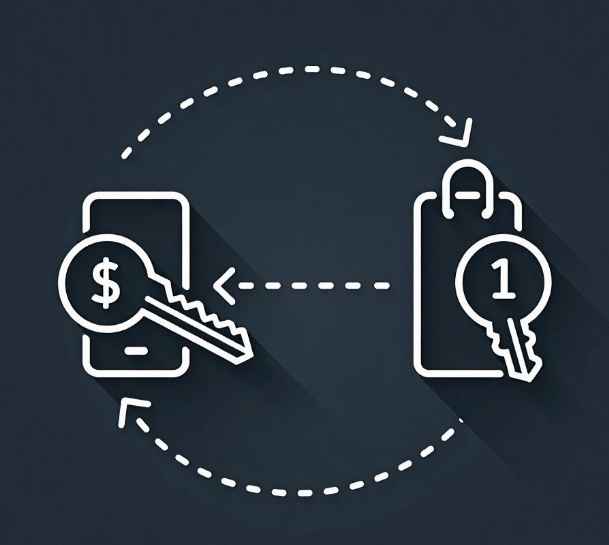Encryption Technology and Data Privacy Protection in Blockchain Development
- latest articles
- 1.DApp Development & Customization: Merging Diverse Market Needs with User Experience 2.Analysis of the Core Technical System in DApp Project Development 3.How to achieve cross-chain interoperability in Web3 projects? 4.How does the tokenization of points reconstruct the e-commerce ecosystem? 5.How to Set and Track Data Metrics for a Points Mall? 6.What is DApp Development? Core Concepts and Technical Analysis 7.Inventory of commonly used Web3 development tools and usage tips 8.Development of a Distribution System Integrated with Social E-commerce 9.Six Key Steps for Businesses to Build a Points Mall System 10.What is DApp Development? A Comprehensive Guide from Concept to Implementation
- Popular Articles
- 1.Future Trends and Technology Predictions for APP Development in 2025 2.Analysis of the DeFi Ecosystem: How Developers Can Participate in Decentralized Finance Innovation 3.From Zero to One: How PI Mall Revolutionizes the Traditional E-commerce Model 4.DAPP Development | Best Practices for Professional Customization and Rapid Launch 5.Recommended by the Web3 developer community: the most noteworthy forums and resources 6.From Cloud Computing to Computing Power Leasing: Building a Flexible and Scalable Computing Resource Platform 7.How to Develop a Successful Douyin Mini Program: Technical Architecture and Best Practices 8.Shared Bike System APP: The Convenient Choice in the Era of Smart Travel 9.How to Create a Successful Dating App: From Needs Analysis to User Experience Design 10.From Design to Development: The Complete Process of Bringing an APP Idea to Life
With the continuous development of the digital era, blockchain technology has gradually entered our field of vision as a disruptive technology. Its applications are becoming increasingly widespread across various sectors such as finance, healthcare, and logistics. Blockchain not only provides decentralized and trustless transaction methods but also offers unique advantages in encryption technology and data privacy protection. This article will delve into encryption technologies in blockchain development and their role in data privacy protection.
I. Overview of Blockchain
Blockchain is a distributed ledger technology characterized by decentralization, immutability, and transparency. In a blockchain system, data is stored in a chain structure maintained by multiple nodes, with each data unit called a "block," and blocks are linked together through cryptographic algorithms. Through consensus mechanisms, blockchain systems ensure data reliability and consistency.
Although the decentralized nature of blockchain gives it advantages in data transmission and transaction verification, it also faces challenges in data privacy protection. Since all transaction records are public, blockchain's privacy becomes complex. In this context, encryption technology has become a key technique for ensuring data privacy and security.
II. Application of Encryption Technology in Blockchain
Encryption technology is the foundation for protecting blockchain data privacy and security. The core of blockchain lies in ensuring data security through cryptographic algorithms and preventing malicious tampering. Below are several common encryption technologies in blockchain.
1. Hash Algorithms
Hash algorithms are a form of one-way encryption technology primarily used for uniquely identifying data in blockchain. In blockchain, each block contains a hash value pointing to the previous block, forming a chain structure. The key characteristic of hash algorithms is their one-way nature, meaning once data is hashed, the original data cannot be derived through reverse computation.
The application of hash algorithms not only ensures the integrity of blockchain data but also guarantees the immutability of each block by generating unique digital fingerprints. For example, SHA-256, a commonly used hash algorithm in blockchain, has strong collision resistance, where even minor data changes result in completely different hash values.
2. Public Key and Private Key Encryption
In blockchain, public and private key encryption technology is central to ensuring transaction security and identity verification. Each blockchain user possesses a pair of public and private keys, where the public key identifies the user, and the private key is used for signing and encrypting transactions. The private key is unique and confidential, while the public key can be shared with other users.
When a user conducts a transaction, they sign the transaction with their private key to ensure the transaction's origin is legitimate. Other nodes can verify the signature's validity using the public key, thereby confirming the transaction's authenticity. This encryption method effectively prevents identity forgery and transaction tampering, safeguarding the blockchain system's security.
3. Homomorphic Encryption
Homomorphic encryption is a cryptographic technique that allows computations to be performed on encrypted data, meaning specific operations can be carried out while the data remains encrypted. Specifically, the computed results, when decrypted, match the results obtained from directly computing on the original data.
Homomorphic encryption has significant applications in blockchain, especially in scenarios requiring privacy protection. For instance, when sharing medical data on a blockchain, homomorphic encryption enables data analysis and computation without exposing patient privacy. Through homomorphic encryption, blockchain can perform necessary data processing and analysis while ensuring data privacy.
4. Zero-Knowledge Proofs
Zero-Knowledge Proof (ZKP) is a cryptographic protocol that allows one party (the prover) to prove to another party (the verifier) that a statement is true without revealing any additional information. In other words, the prover can demonstrate knowledge of certain information without disclosing the information itself.
In blockchain, zero-knowledge proofs can be applied to scenarios such as identity verification and transaction privacy. For example, cryptocurrencies like Zcash utilize zero-knowledge proof technology to ensure transaction privacy. Through zero-knowledge proofs, transaction parties can prove the legitimacy of a transaction without exposing its content, thereby protecting user privacy.
III. Challenges and Solutions in Data Privacy Protection
Although blockchain offers decentralization and transparency, its openness and immutability also present challenges in privacy protection. Especially as blockchain applications become more widespread, balancing the advantages of transparency and decentralization with user privacy protection has become a critical issue.
1. Privacy Issues in Blockchain
On public blockchains, every transaction is recorded on the chain and is viewable by anyone. This means users' transaction histories and asset information may be exposed. Moreover, due to blockchain's immutability, once sensitive information is recorded, it cannot be altered or deleted.
For example, if someone conducts a large transaction on a blockchain, others can trace this transaction through public records and infer the user's asset status. If this information is maliciously exploited, it could pose security risks to the user.
2. Solutions for Privacy Protection
To address these privacy challenges, the blockchain community has proposed several privacy protection solutions, primarily including the following technologies:
(1) Coin Mixing Technology
Coin mixing technology obscures the origin and destination of transactions by mixing multiple users' transactions together, making it difficult for outsiders to trace each transaction's initiator. Common mixing services include Bitcoin mixing services and Ethereum's mixing protocols. This method effectively hides transaction sources and destinations, enhancing privacy protection.
(2) Zero-Knowledge Proof Technology
As mentioned earlier, zero-knowledge proof technology allows users to prove the legitimacy of transactions without exposing sensitive information. The use of zero-knowledge proofs not only protects user privacy but also enhances system privacy without compromising blockchain transparency.
(3) Privacy Chain Technology
Some blockchain projects, such as Monero and Zcash, employ privacy chain technology to completely hide the identities of transaction parties and transaction content through encryption and anonymization mechanisms. Monero uses ring signatures and stealth addresses, while Zcash utilizes zero-knowledge proofs. These privacy chains protect privacy while maintaining blockchain's decentralization and security.
3. Future Trends in Privacy Protection
As blockchain technology continues to evolve and find applications, the demand for privacy protection will also increase. In the future, blockchain may focus more on improving privacy protection mechanisms, such as through more efficient homomorphic encryption, zero-knowledge proofs, and privacy chain technologies to protect sensitive data. Simultaneously, compliance and legal regulations will become significant factors influencing blockchain privacy protection. Balancing privacy protection with transparency while adhering to data protection laws will be a key challenge in blockchain development.
IV. Conclusion
Encryption technology and data privacy protection are two crucial components of blockchain technology. Through encryption technologies such as hash algorithms, public-private key encryption, homomorphic encryption, and zero-knowledge proofs, blockchain can effectively ensure data security and user privacy. However, as blockchain applications expand, privacy protection still faces numerous challenges. In the future, with technological advancements and regulatory improvements, blockchain will be able to leverage its advantages of decentralization and transparency while protecting privacy, driving innovation across various industries.
-

How to achieve cross-chain interoperability in Web3 projects?
With the continuous development of WEB3 technology, Web3 has gradually become an···
-

Inventory of commonly used Web3 development tools and usage tips
With the continuous development of blockchain technology, Web3 has become a hot ···
-

Web3 development trend prediction: analysis of future technology directions and application scenarios
With the gradual development of blockchain technology, the concept of Web3 has m···

 Blockchain
Blockchain












